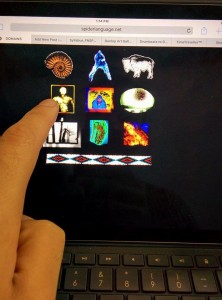A critical analysis for UBC course FNIS 401F, Indigenous New Media, by Mario Parent.
Isi-pîkiskwêwin-Ayapihkêsîsak (Speaking the Language of Spiders), 1996, is an interactive screenplay and multimedia storyboard website. The website is organized by Cree/French, Métis artist Ahasiw Maskegon-Iskwew in collaboration with several Indigenous artists who contributed literary, aural, and visual media pieces. The web based art piece focuses on the construction of reality as determined by language. Specifically, Isi-pîkiskwêwin-Ayapihkêsîsak makes use of both English and First Nations languages. The effect Isi-pîkiskwêwin-Ayapihkêsîsako captures is the multifaceted ideological worldviews First Nations people utilize, navigate, and struggle with upon the historical and ongoing colonization of Canada.
Navigating the website on my iPad I was intuitively engaged by First Nations visual media icons, which acted as the metaphorical and spiritual guides of the website. Fittingly, the spider is a common guide throughout the intersections of storyboards. Each of the nine introductory visual media icons lead to a different visual media, which then lead to a poem, and audio. The visual media are computer rendered and stylized images often containing text. For example, Time Of The Superbeings incorporates the repetitive stylized portrait photo of a woman contained in the English letter X. The text in “Time Of The Superbeings” references to the Algonquin supernatural beings the Manitous; furthermore, the text suggests Humans and Manitous can utilize the supernatural power of Internet domains to influence the earth. As the artists statement suggests, the objective of Isi-pîkiskwêwin-Ayapihkêsîsak is to provide space for marginalized peoples to participate in the telling of their stories, which have a global influence when shared via the internet.
Beyond the visual media are poems. The poem’s subject matter concentrates on the voices of First Nations who have been marginalized in urban centres. Each poem speaks to the unique resilience of Indigenous peoples to move beyond victimization. Furthermore, the poems provide space to voice harsh realities and aspirations of hope. Poems like Sky Woman highlight aspirations of hope while poems like Lies We Tell Each Other voices the struggle of a marginalized life. The spectrum of harsh realities to aspirations of hope in the literature is a holistic approach Isi-pîkiskwêwin-Ayapihkêsîsak utilizes in representing First Nations experiences.
The web piece as a whole contrasts and intersects the concept of how languages construct reality through the use of multiple media. At first glance I had trouble seeing how the English language may inform the construction of realities depicted in the literature itself in a direct dialogue. Though, further reading and suplemented theory aided my understanding. The construct of reality as informed by the English language is the affect of historical and ongoing Canadian colonialism imposed on First Nations. Moreover, Canadian colonialism demands the use of the English language as a universal language, holding the written word as the highest form of authority. The codified First Nations realities written in the English language challenges the imposed authority of Canadian colonialism by gaining recognition in the global arena of the internet.
The combinations of visual media, literature, and audio on a web based platform was ahead of its time when inititially released in 1996. Even today, in 2015, when adapted and viewed on an iPad Isi-pîkiskwêwin-Ayapihkêsîsak has the feel and engagement of a contemporary app. The only issue I had in viewing the piece was the audio did not play. I was inspired by how the piece engages with the medium of the Internet and decided in the creation of my blog post to add as many clickable links. In 2015 Isi-pîkiskwêwin-Ayapihkêsîsak continues its legacy in the recognition of First Nations voices as a website and in the responses to the website.



Hi Mario,
Great work here. You provide excellent summary and analysis and illustrate the prescience of Maskegon-Iskwew work. I particularly like your thoughts on language here and your use of images (it’s neat to see this piece at work on an ipad, which Maskegon-Iskwew could have only imagined at the time). Keep up the great work. I look forward to reading more.
I agree that Ahasiw Maskegon-Iskwew was creating into the future with Isi-pîkiskwêwin-Ayapihkêsîsak. Creating such a richly layered and interactive piece in the 1990’s is in itself a feat, and I can’t get over how powerful it is today, 20 years later. I was struck by how I interacted with the piece and how it forced me to examine my own perspectives, prejudices, history and future and how they constructed my interaction with the piece. You got something different out of Speaking the Language of Spiders. It made you think of the power of language as a colonizing and decolonizing tool, for instance. I didn’t even think of that! Other analyses in our class focused on the fractious relationship of settler and Indigenous voices in art, the visual and structural components of the piece, and how to resist decolonization by art and being Indigenous (I don’t know how to link to other blogs in a comment, so no citations on that…). Speaking the Language of Spiders made us all think about decolonization in our own way. A 20 year old, largely un-maintained website being that powerful just blows my mind.